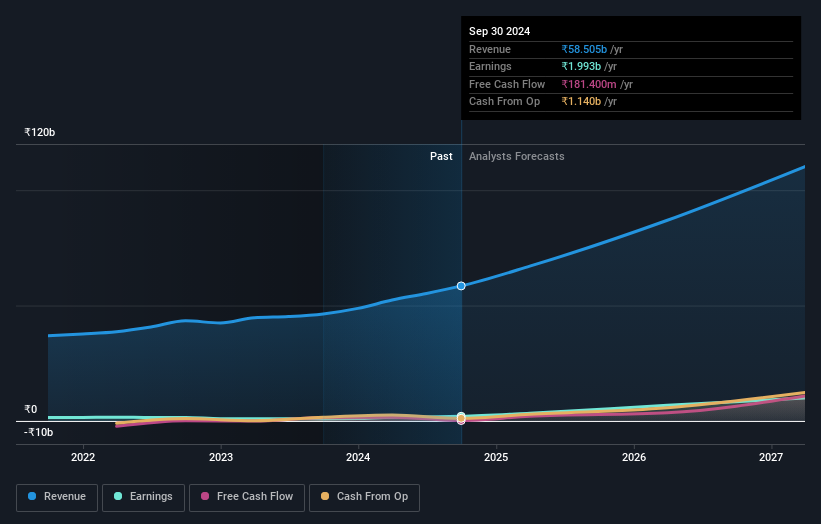- India
- /
- Electrical
- /
- NSEI:POWERINDIA
Public companies are Hitachi Energy India Limited's (NSE:POWERINDIA) biggest owners and were rewarded after market cap rose by ₹58b last week

Key Insights
- The considerable ownership by public companies in Hitachi Energy India indicates that they collectively have a greater say in management and business strategy
- The largest shareholder of the company is Hitachi, Ltd. with a 75% stake
- Institutional ownership in Hitachi Energy India is 12%
A look at the shareholders of Hitachi Energy India Limited (NSE:POWERINDIA) can tell us which group is most powerful. We can see that public companies own the lion's share in the company with 75% ownership. In other words, the group stands to gain the most (or lose the most) from their investment into the company.
Clearly, public companies benefitted the most after the company's market cap rose by ₹58b last week.
Let's delve deeper into each type of owner of Hitachi Energy India, beginning with the chart below.
Check out our latest analysis for Hitachi Energy India

What Does The Institutional Ownership Tell Us About Hitachi Energy India?
Institutions typically measure themselves against a benchmark when reporting to their own investors, so they often become more enthusiastic about a stock once it's included in a major index. We would expect most companies to have some institutions on the register, especially if they are growing.
Hitachi Energy India already has institutions on the share registry. Indeed, they own a respectable stake in the company. This suggests some credibility amongst professional investors. But we can't rely on that fact alone since institutions make bad investments sometimes, just like everyone does. It is not uncommon to see a big share price drop if two large institutional investors try to sell out of a stock at the same time. So it is worth checking the past earnings trajectory of Hitachi Energy India, (below). Of course, keep in mind that there are other factors to consider, too.

Hitachi Energy India is not owned by hedge funds. The company's largest shareholder is Hitachi, Ltd., with ownership of 75%. This implies that they have majority interest control of the future of the company. For context, the second largest shareholder holds about 1.5% of the shares outstanding, followed by an ownership of 1.1% by the third-largest shareholder.
While it makes sense to study institutional ownership data for a company, it also makes sense to study analyst sentiments to know which way the wind is blowing. There are a reasonable number of analysts covering the stock, so it might be useful to find out their aggregate view on the future.
Insider Ownership Of Hitachi Energy India
The definition of company insiders can be subjective and does vary between jurisdictions. Our data reflects individual insiders, capturing board members at the very least. Company management run the business, but the CEO will answer to the board, even if he or she is a member of it.
Insider ownership is positive when it signals leadership are thinking like the true owners of the company. However, high insider ownership can also give immense power to a small group within the company. This can be negative in some circumstances.
Our data cannot confirm that board members are holding shares personally. Not all jurisdictions have the same rules around disclosing insider ownership, and it is possible we have missed something, here. So you can click here learn more about the CEO.
General Public Ownership
The general public-- including retail investors -- own 13% stake in the company, and hence can't easily be ignored. While this group can't necessarily call the shots, it can certainly have a real influence on how the company is run.
Public Company Ownership
Public companies currently own 75% of Hitachi Energy India stock. We can't be certain but it is quite possible this is a strategic stake. The businesses may be similar, or work together.
Next Steps:
I find it very interesting to look at who exactly owns a company. But to truly gain insight, we need to consider other information, too.
I always like to check for a history of revenue growth. You can too, by accessing this free chart of historic revenue and earnings in this detailed graph.
If you would prefer discover what analysts are predicting in terms of future growth, do not miss this free report on analyst forecasts.
NB: Figures in this article are calculated using data from the last twelve months, which refer to the 12-month period ending on the last date of the month the financial statement is dated. This may not be consistent with full year annual report figures.
Valuation is complex, but we're here to simplify it.
Discover if Hitachi Energy India might be undervalued or overvalued with our detailed analysis, featuring fair value estimates, potential risks, dividends, insider trades, and its financial condition.
Access Free AnalysisHave feedback on this article? Concerned about the content? Get in touch with us directly. Alternatively, email editorial-team (at) simplywallst.com.
This article by Simply Wall St is general in nature. We provide commentary based on historical data and analyst forecasts only using an unbiased methodology and our articles are not intended to be financial advice. It does not constitute a recommendation to buy or sell any stock, and does not take account of your objectives, or your financial situation. We aim to bring you long-term focused analysis driven by fundamental data. Note that our analysis may not factor in the latest price-sensitive company announcements or qualitative material. Simply Wall St has no position in any stocks mentioned.
About NSEI:POWERINDIA
Hitachi Energy India
Offers products, projects, and services for electricity transmission and related activities in India and internationally.
Exceptional growth potential with outstanding track record.
Similar Companies
Market Insights
Community Narratives



